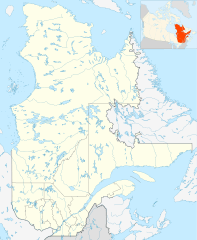Pakuashipi facts for kids
Quick facts for kids
Pakuashipi
Pakua Shipu
|
|
|---|---|
|
Indigenous settlement
|
|
| Country | Canada |
| Province | Quebec |
| Region | Côte-Nord |
| RCM | Le Golfe-du-Saint-Laurent |
| Established | 1971 |
| Area | |
| • Land | 3.93 km2 (1.52 sq mi) |
| Population
(2016)
|
|
| • Total | 237 |
| • Density | 60.3/km2 (156/sq mi) |
| • Change (2016–11) | |
| • Dwellings | 90 |
| Time zone | UTC−04:00 (AST) |
| Postal Code |
G0G 2R0
|
| Area code(s) | 418 and 581 |
Pakuashipi (also known as Pakua Shipi or Pakua Shipu in the Innu-aimun language) is a special Indigenous settlement in Quebec, Canada. It's located on the north shore of the Gulf of Saint Lawrence, a large body of water. This community is part of the Côte-Nord region.
Pakuashipi is on the west side of the Saint-Augustin River's mouth. Across the river is the town of Saint-Augustin. Pakuashipi is not an official Indian reserve. Instead, it's an Indian settlement within the Municipality of Saint-Augustin. The land is used by the Innu people of Pakua Shipi.
The name "Pakuashipi" comes from the Saint-Augustin River. It means "shallow river" in Innu-aimun. This is because pakua means "drained" or "dried up," and shipi means "river." Other Innu groups call the people from this settlement Pakua-shipiunnuat. They are known for keeping their culture and language very traditional.
The community has many important services. These include a health centre, a community centre, and a church. There is also a school, a community store, and a youth centre. Residents benefit from a local radio station, an inn, and a modern water and sewer system. The settlement also has its own fire station and an Indigenous police force.
Contents
History of Pakuashipi
Early Innu and European Contact
The area where Pakuashipi is located was originally home to Innu and Inuit tribes. These groups were nomadic, meaning they moved around. However, when Europeans started using the land, many Indigenous people were forced to move.
Efforts to Establish a Reserve
In July 1949, the Government of Quebec offered land to the Innu people. This land was about 1.3 hectares (3.2 acres) and was meant to become an Indian reserve. But the Government of Canada said no. They felt the population was too small to create a reserve.
In the early 1960s, the federal government tried to help the Saint-Augustin Innu group. They decided to combine them with the band at the La Romaine reserve. The government then moved the Saint-Augustin group there. But during a storm one night, the group returned to their traditional homeland.
Official Recognition and Name Change
On June 4, 1971, the Quebec Ministry of Lands and Forests gave permission. This allowed the Government of Canada to build homes for the First Nations people of Saint-Augustin. These homes were built on the current site of Pakuashipi.
Later, on July 27, 1987, the Saint-Augustin Band changed its name. They became known as the "Pakua Shipi Montagnais Band."
Community Population
Population Trends Over Time
As of July 2021, the Pakua Shipi band had 401 registered members. In 2016, the total population was 237 people. There were 65 homes occupied by residents out of 90 total dwellings.
Here's how the population has changed:
- In 2016: 237 people
- In 2011: 312 people
- In 2006: 289 people
- In 2001: 228 people
- In 1996: 242 people
- In 1991: 211 people
Languages Spoken
The 2016 Canadian census looked at the first languages people spoke in Pakuashipi.
- Most people, 87.28%, spoke Innu-aimun as their first language.
- About 6.4% spoke French as their first language.
- No one reported English as their first language.
- About 6.4% spoke other languages.
Education in Pakuashipi
The settlement has one school called École Pakuashipish. This school teaches students from pre-Kindergarten up to Secondary grade 4. In the 2008-2009 school year, 88 students were enrolled there.


